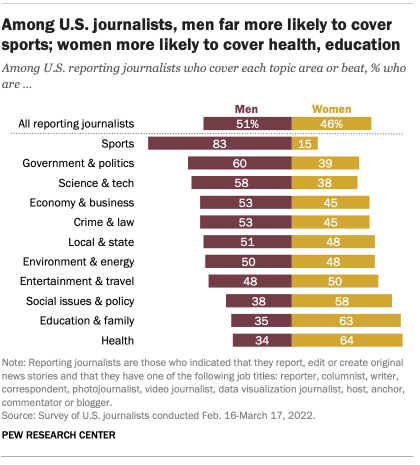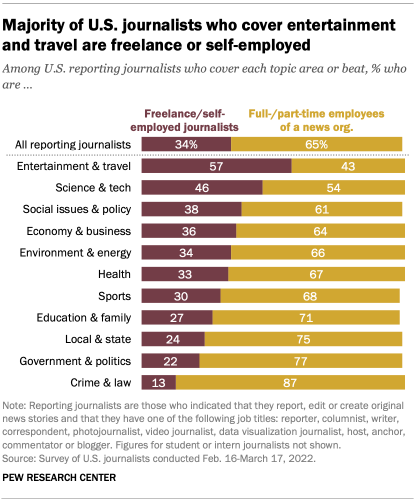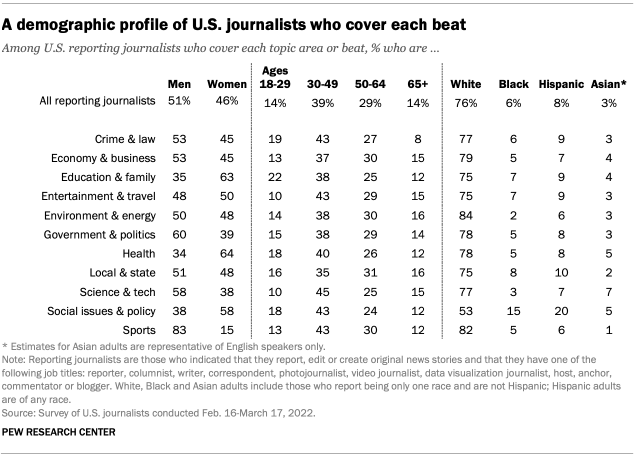US journalists’ beats vary by gender, employment status, race and ethnicity

[ad_1]

The beats American journalists cover vary widely by gender and other factors, according to a new analysis of a Pew Research Center survey of nearly 12,000 working U.S.-based journalists conducted in 2022. The analysis comes amid continued discussion about the demographic composition of U.S. newsrooms.

The survey asked reporting journalists to identify up to three topic areas or beats that they cover regularly, 11 of which had large enough sample sizes to study. Men are far more likely than women to cover certain beats – especially sports – while journalists who are women are more likely than men to cover news about social issues, education and health.
Men account for 83% of the surveyed journalists who indicated that they cover sports, far higher than the 15% who are women. Men also account for majorities of those who cover political news (60%) and news about science and technology (58%).
By comparison, women are more likely than men to cover three of the 11 news beats studied: health, education and families, and social issues and policy. For instance, women account for nearly two-thirds (64%) of surveyed journalists who cover news about health, while only about a third (34%) are men.
The source of data for this analysis is a Pew Research Center survey of 11,889 U.S.-based journalists who are currently working in the news industry and say that they report, edit or create original news stories in their current job. The survey was conducted online between Feb. 16 and March 17, 2022.
Because there is no readily available list of all U.S. journalists, Center researchers relied on commercial databases of journalists based in the U.S., as well as supplemental lists of news organizations to create a broad and diverse sample of over 160,000 journalists from as many types of outlets and areas of reporting as possible. Although it is impossible to be certain every segment of the journalism profession in the U.S. is covered by the sample, the use of multiple databases and supplemental lists ensured that journalists from a variety of different reporting areas, news platform types, as well as outlet sizes and types – such as those who work for organizations that are intended to primarily reach a particular demographic group – were represented.
Propensity weighting was used to ensure that the responses of the 11,889 respondents aligned with the full sample of over 160,000 journalists with respect to job titles, media outlet type, freelance status and geographic location.
This analysis looks at the journalists who cover 11 topic areas or beats. In the survey, reporting journalists were asked to write down up to three topic areas they report on in a typical month. In the survey, reporting journalists are those who indicated that they have one of the following job titles: reporter, columnist, writer, correspondent, photojournalist, video journalist, data visualization journalist, host, anchor, commentator or blogger. About three-quarters of all journalists surveyed (76%) are reporting journalists.
Researchers coded these open-ended responses into distinct categories. Eleven of the coded topic areas (or beats) had enough reporting journalists in our sample to reliably study: crime and law, economy and business, education and family, entertainment and travel, environment and energy, government and politics, health, local and state, science and technology, social issues and policy, and sports.
Refer to the topline for the questions asked in the survey. For more information on the development of the sample of journalists or the survey weighting., please read the methodology.
This is the latest analysis in Pew Research Center’s ongoing investigation of the state of news, information and journalism in the digital age, a research program funded by The Pew Charitable Trusts, with generous support from the John S. and James L. Knight Foundation.
The remaining five beats studied – economy, crime and law, local and state, environment and energy, and entertainment and travel – are more evenly split between men and women journalists.
Overall, 51% of the reporting journalists surveyed are men and 46% are women. In the survey, reporting journalists are those who indicated that they have one of the following job titles: reporter, columnist, writer, correspondent, photojournalist, video journalist, data visualization journalist, host, anchor, commentator or blogger. About three-quarters of all journalists surveyed (76%) are reporting journalists.
Majority of journalists who cover entertainment, travel are freelancers or self-employed

Journalists’ beats also vary by their employment status – that is, whether they are freelance or self-employed journalists, or full- or part-time journalists at a news organization.
Entertainment and travel stands out as the only topic area in which a majority of those who cover it (57%) are freelance or self-employed journalists. Nearly half of journalists who cover science and technology (46%) are also freelancers or self-employed.
On the other hand, some beats are overwhelmingly covered by either full- or part-time employees of news organizations. For instance, 87% of reporting journalists who cover crime and law fall into this category.
Overall, about a third of the reporting journalists surveyed (34%) indicated that they are freelance or self-employed, compared with about two-thirds (65%) who are full- or part-time employees of a news organization.
Journalists’ beats vary somewhat by race, ethnicity
Journalists’ beats also differ modestly by other demographic factors, including race and ethnicity.
One reporting area particularly stands out by the race and ethnicity of the journalists who cover it: social issues and policy. Hispanic and Black journalists make up a greater portion of those who cover this beat (20% and 15%, respectively) than any other studied.

White journalists make up about half (53%) of those who report on social issues and policy, but they make up large majorities of the other 10 beats studied, including 84% of those who cover environment and energy. Asian journalists account for no more than 7% of those who cover any of the 11 beats studied.
Overall, 76% of all reporting journalists surveyed indicated that they are White, while 8% are Hispanic, 6% are Black and 3% are Asian. These figures align closely with previous research showing that a large portion of newsrooms’ employees are White, higher than the share of U.S. workers overall who are White.
Note: Here are the questions used for the report, along with responses, and the survey methodology.


[ad_2]
Source link
